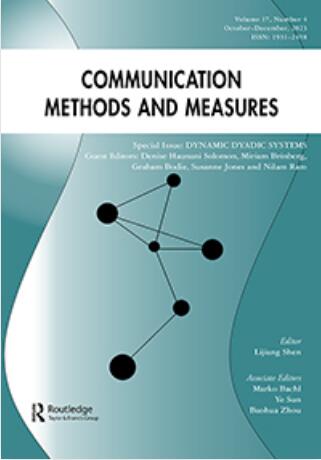人际对话的动态二元系统视角
IF 3.7
1区 文学
Q1 COMMUNICATION
引用次数: 1
摘要
本文章由计算机程序翻译,如有差异,请以英文原文为准。
A Dynamic Dyadic Systems Perspective on Interpersonal Conversation
ABSTRACT Conversations between people are where, among other things, stressors are amplified and attenuated, conflicts are entrenched and resolved, and goals are advanced and thwarted. What happens in dyads’ back-and-forth exchanges to produce such consequential and varied outcomes? Although numerous theories in communication and in social psychology address this question, empirical tests of these theories often operationalize conversational behavior using either discrete messages or overall features of the conversation. Dynamic systems theories and methods provide opportunities to examine the interdependency, self-stabilization, and self-organization processes that manifest in conversations over time. The dynamic dyadic systems perspective exemplified by the articles in this special issue (a) focuses inquiry on the turn-to-turn, asynchronous exchange of messages between two partners, (b) emphasizes behavioral patterns within and the structural and temporal organization of conversations, and (c) adapts techniques used in analysis of intensive longitudinal data to identify and operationalize those dynamic patterns. As an introduction to the special issue, this paper describes a dynamic dyadic systems perspective on conversation and discusses directions for future research, such as applications to human-computer interaction, family communication patterns, health care interventions, and group deliberation.
求助全文
通过发布文献求助,成功后即可免费获取论文全文。
去求助
来源期刊

Communication Methods and Measures
COMMUNICATION-
CiteScore
21.10
自引率
1.80%
发文量
9
期刊介绍:
Communication Methods and Measures aims to achieve several goals in the field of communication research. Firstly, it aims to bring attention to and showcase developments in both qualitative and quantitative research methodologies to communication scholars. This journal serves as a platform for researchers across the field to discuss and disseminate methodological tools and approaches.
Additionally, Communication Methods and Measures seeks to improve research design and analysis practices by offering suggestions for improvement. It aims to introduce new methods of measurement that are valuable to communication scientists or enhance existing methods. The journal encourages submissions that focus on methods for enhancing research design and theory testing, employing both quantitative and qualitative approaches.
Furthermore, the journal is open to articles devoted to exploring the epistemological aspects relevant to communication research methodologies. It welcomes well-written manuscripts that demonstrate the use of methods and articles that highlight the advantages of lesser-known or newer methods over those traditionally used in communication.
In summary, Communication Methods and Measures strives to advance the field of communication research by showcasing and discussing innovative methodologies, improving research practices, and introducing new measurement methods.
 求助内容:
求助内容: 应助结果提醒方式:
应助结果提醒方式:


